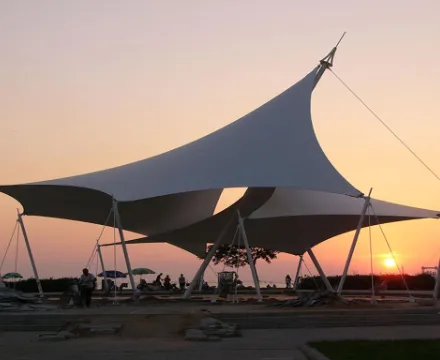Dapeng Town Industrial Park, Tongshan District, Xuzhou City, Jiangsu Province, China
After the completion of the membrane structure canopy roofing, we must attach great importance to maintenance and maintenance to ensure normal use. This is different from ordinary buildings. During a period of time after completion, we must inspect and maintain, and provide maintenance and repair manuals to the user. Long-term maintenance and maintenance should be carried out by professionals.
Within one year of the completion of the project, the SAFS steel structure will carry out routine inspection and maintenance of the membrane structure 1-2 times. If necessary, pre-tension reinforcement or other measures should be taken. If the connecting parts are loose, they will be re-tightened or reinforced.
The stability of the membrane structure depends on the maintenance of the prestress in the membrane.The level of prestress affects the deformation of the membrane under load.If the prestress is too low, the membrane will have a large displacement and flutter under the action of wind.
Because the membrane will relax and creep under the continuous action of the load, the prestress in the membrane will change during the trial period.The pre-stress level detection can be obtained by simple methods such as pushing the membrane material or feeling the resistance of the buckling belt to lateral displacement, or by on-site testing by means of tension meter load cells or geometric measurement.
The membrane structure should be cleaned regularly, and professional cleaning agents should be used during cleaning. From a technical point of view, the membrane structure does not necessarily require cleaning. For most membrane materials, cleaning can not prolong their working life, on the contrary, improper cleaning will shorten their life.
The accumulation of fouling on the membrane surface is related to local environmental conditions, membrane properties and the shape of the membrane surface. In order to facilitate cleaning, it should be considered in the design stage to provide access to the roof for cleaning personnel and connectors for easy fixing of safety ropes and safety ropes.
When cleaning, it should be ensured that the surface treatment layer of PVDF and FEP coating materials is not damaged. Therefore, scrubbing agents, strong solvents, hard brushes and high-pressure water jets cannot be used. Compared to household soaps or dishwashing detergents, general film cleaners are generally relatively safe, but long-term contact with skin, eyes and mucous membranes must also be avoided. In addition, cleaning personnel must wear soft-soled shoes when walking on the roof.
The membrane surface will be slippery when wet, so safety measures such as safety ropes and anti-fall nets should be used. Considering that damage such as breakage may occur when cleaning old buildings, safety nets should be arranged under them.
The membrane surface should be inspected and cleaned before the rainy season and winter every year to keep the drainage system of the membrane surface unobstructed; necessary snow melting and snow removal emergency measures should be taken in areas with heavy snow load. Due to the deformation of the membrane material under the load, there may be water accumulation at the small slope of the membrane surface. After heavy rainfall or snowfall and the snow melts, the tensioned membrane structure should be monitored to avoid water accumulation. If standing water occurs, the standing water or snow must be removed immediately. If the rainy and snowy weather continues, water accumulation will damage the membrane material, so the space covered by the membrane surface should be closed to the public, and measures should be taken immediately to avoid new accumulation of water.